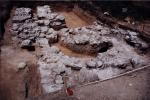Summary (English)
Since 2004, the Museum of Lika in Gospić has been implementing the project of systematic research of the medieval sacral sites in the area of the village of Smiljan. One of the goals of this project, which includes archaeological excavations and the presentation of cultural heritage sites, is the discovery of the location of the church from which two architectural fragments with pre-Romanesque guilloche (interlace) patterns originate. They were found secondarily embedded in the Smiljan burial chapel more than two decades ago and today are kept in the Museum of Lika.
As part of this project, in 2006, systematic excavation continued at the location of Crikvina, in the hamlet of Čovini, with the remains of the church destroyed by the Turkish conquests and burned in 1535. The site is located at cadastral plot 1575, cadastral municipality of Smiljan, on private land which is not farmed due to the legend about the “old church”. Parts of the building also extend to surrounding plots that do not belong to the owner of the land where excavations are currently being conducted. The site is located in the central part of the field, on a slightly elevated ridge, not far from the right bank of the Otešica River and the Mandinac Spring.
This season lasted 15 working days (from July 4 to 20, 2006) and an area of approx. 40 m² was excavated, while the excavation of last year’s quadrant was also completed (in two seasons the total area is approx. 80 m²). During the first season of excavation, the remains of a church with a very shallow semi-circular apse and a southern perimeter wall were discovered, and, as was assumed at the time, its extension. By this year’s excavation, the remains of two single-nave churches with semi-circular apses were established. They are oriented east-west. The older of the two, with a very shallow apse, was almost completely destroyed when the new church was built. Graves from a multi-phased cemetery were also excavated at the location. Burials were established inside and outside both churches, and 26 graves in total were found (eight in the first season, and eighteen in 2006). So far, three burial phases have been defined, which mostly follow the phases of construction. Burials were all placed in simple graves dug in the soil, without traces of wooden coffins or grave architecture, while in two burials the remains of a wooden plank on which the deceased was laid were recorded (second burial phase). Most of the graves are without finds, which were found in only two of them: a bronze ring in grave 23, and an iron buckle in grave 24. In general, discovered finds were very few, but they date the site in the High, and even in the Late Middle Ages (Tatjana Kolak 2007, Hrvatski arheološki godišnjak 3/2006, 325–326).
- Tatjana Kolak
Director
- Tatjana Kolak
Team
- Jasmina Osterman
Research Body
- Muzej Like Gospić






![Download [PDF]](/excavation/skins/fasti/images/results/download_sml.png)
